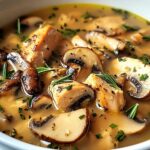The humble Boxty is a staple of Irish comfort food, known for its satisfying texture and simplicity. Combining mashed and grated raw potato, it delivers a crisp exterior with a tender, almost creamy center. Often enjoyed as part of a full Irish breakfast, Boxty also makes a versatile side or savory snack.
Rooted in Irish heritage, Boxty has been lovingly passed down through generations. It speaks to the frugal creativity of rural Irish cooking—taking a common ingredient and transforming it into something extraordinary. Whether topped with a fried egg, served with smoked salmon, or simply with a pat of butter, these pancakes are a delicious slice of Ireland’s culinary soul.
Full Recipe
Ingredients:
-
1 cup raw grated potato
-
1 cup mashed potato
-
1 cup all-purpose flour
-
1 teaspoon baking powder
-
1/2 teaspoon salt
-
1/4 teaspoon black pepper
-
3/4 cup buttermilk (or more if needed)
-
2 tablespoons butter (for frying)
-
Fresh chives or parsley, chopped (optional, for garnish)
Directions:
-
Grate the raw potatoes and place them in a clean kitchen towel. Squeeze out as much moisture as possible.
-
In a large mixing bowl, combine the grated raw potato, mashed potato, flour, baking powder, salt, and pepper.
-
Stir in the buttermilk gradually until you get a thick but pourable batter.
-
Heat a skillet over medium heat and add a bit of butter.
-
Drop the batter by large spoonfuls onto the skillet, flattening slightly with the back of the spoon to form a pancake shape.
-
Fry each side for about 3-4 minutes or until golden brown and cooked through.
-
Repeat with remaining batter, adding more butter as needed.
-
Garnish with fresh chives or parsley if desired, and serve warm.
Prep Time: 10 minutes | Cooking Time: 20 minutes | Total Time: 30 minutes
Kcal: 190 kcal | Servings: 4 servings
A Taste of Irish Tradition: The Story Behind Boxty
Boxty is more than just a potato pancake—it’s a dish woven into the rich tapestry of Irish culinary history. Hailing primarily from the northwestern counties of Ireland, such as Leitrim, Mayo, Sligo, and Donegal, Boxty holds a unique place in Irish heritage, often recited in the traditional rhyme: “Boxty on the griddle, Boxty in the pan, if you can’t make Boxty, you’ll never get a man!” While the origins of this light-hearted poem are up for debate, it underscores the dish’s long-standing cultural significance and its once-essential place in Irish kitchens.
Boxty was traditionally seen as a way to make the most out of the humble potato—an ingredient synonymous with Irish cuisine. Its resourcefulness speaks volumes of how Irish households would stretch ingredients to feed large families during hard times, especially during and after the Great Famine of the 1840s. In many rural homes, Boxty became a staple, made with minimal ingredients and often cooked over an open hearth on a cast-iron griddle.
What Makes Boxty Unique?
Unlike most potato dishes, Boxty uses both raw grated potato and cooked mashed potato, creating a texture that is both crispy and creamy. This duality in preparation gives Boxty a unique mouthfeel—crunchy on the outside, soft and flavorful on the inside. It can be shaped into small patties, fried like pancakes, or even baked into loaves depending on regional preferences and family traditions.
The inclusion of buttermilk gives it a distinct tang and lightness, while a bit of flour helps bind everything together. Though the basic version is simple, Boxty serves as a versatile base for toppings and accompaniments, making it perfect for experimentation or creative plating.
Regional Variations of Boxty
There are several ways Boxty can be prepared, depending on regional and familial customs. The three most common styles include:
-
Boxty on the Pan: The pancake style featured in this recipe, where the potato mixture is dropped onto a skillet and cooked until golden brown.
-
Boxty on the Griddle: Often made as a thicker batter and cooked slowly over a hot griddle or stone. This version is denser and more filling.
-
Boxty Loaf (Baked Boxty): A more modern take where the batter is poured into a loaf tin and baked in the oven, resulting in a bread-like consistency.
Each version carries the same base ingredients but yields vastly different textures and serving possibilities.
Modern Twists and Serving Ideas
In contemporary kitchens, Boxty is seeing a resurgence not only in Irish homes but in fine dining establishments and international Irish pubs. While the traditional method remains revered, chefs are elevating the dish by pairing it with gourmet toppings and fillings. Think smoked salmon and crème fraîche, poached eggs and hollandaise, or wild mushrooms and fresh herbs.
Boxty is also a delightful gluten-free option when the flour is swapped out for a suitable alternative like rice or chickpea flour. It pairs beautifully with both sweet and savory components, making it a versatile player in any meal—from breakfast to dinner or even as a creative canapé at a party.
Boxty’s Cultural Significance and Revival
Despite the influx of global cuisines and modern cooking trends, traditional dishes like Boxty continue to thrive, especially among those looking to reconnect with their Irish roots. Festivals in parts of Ireland now feature Boxty cooking contests, and local eateries proudly list it on their menus. Its ability to adapt with the times while preserving its soul makes it a symbol of culinary resilience.
Food historians and cookbook authors have taken renewed interest in dishes like Boxty, recognizing the value in preserving heritage through food. In a world dominated by fusion and fast food, there’s something deeply satisfying about returning to ancestral recipes that speak of home, history, and heart.
Tips for Perfecting Your Boxty
Though simple in concept, Boxty rewards attention to detail. Here are a few tips to perfect your pancake:
-
Drain the grated potato well: Excess water will make the batter soggy and prevent it from crisping properly.
-
Use freshly mashed potatoes: Leftover mash can work, but freshly mashed potatoes without butter or cream yield better texture and consistency.
-
Adjust the batter as needed: Depending on the moisture content of your potatoes, you may need to add a touch more buttermilk or flour.
-
Cook low and slow: Don’t rush the process. Cooking at medium to medium-low heat allows the inside to cook through without burning the outside.
Pairing Boxty with Drinks and Sides
If you’re enjoying Boxty as a breakfast dish, serve it alongside poached eggs, grilled tomatoes, and rashers (Irish bacon) with a strong cup of tea or coffee. For a more refined brunch, pair it with smoked fish and a glass of crisp white wine or sparkling prosecco.
At dinner, Boxty can complement hearty stews, roasted meats, or creamy mushroom sauces. A robust Irish stout or even a glass of red wine can balance the earthy flavors of the potatoes.
Bringing Irish Flavors to Your Table
What makes Boxty so appealing is its humble origin and comforting simplicity. It carries with it the flavors of Irish fields, the warmth of a home kitchen, and the legacy of generations. Cooking Boxty at home connects you to a culinary tradition that transcends borders and time. Whether you’re Irish by heritage or simply in spirit, this dish is a delicious way to bring a little bit of Ireland into your home.
Conclusion
Boxty is more than just a recipe—it’s a celebration of Irish ingenuity, resilience, and love for simple, hearty food. Its unique combination of mashed and grated potato, the rustic method of cooking, and its adaptability to modern tastes make it a dish worth mastering. Whether you’re honoring your Irish roots or exploring international comfort food, Boxty brings warmth to the table in every golden bite.
By cooking and sharing Boxty, we honor the generations who crafted meals from humble ingredients and remind ourselves that the heart of cooking lies not in complexity but in care. So the next time you crave comfort food with history and soul, let Boxty be your go-to. Sláinte!






